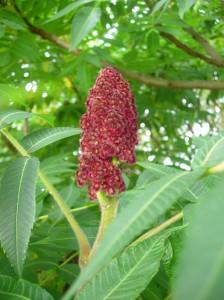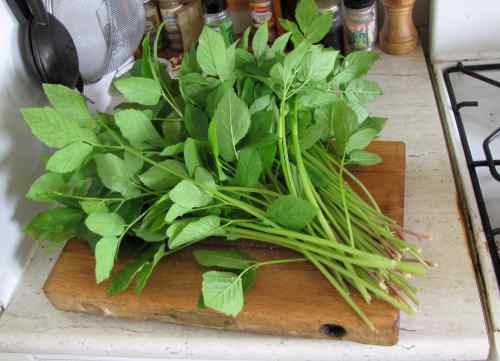Stag Horn Sumac – Rhus typhina
The Forager’s Lemon

Sumac is one of those plants you may have seen a thousand times but never really realised it had an edible use. It’s not a truly wild plant in the UK but it does readily escape from gardens as it sends up suckers when the roots are disturbed. In this way trees can ‘escape’ from gardens over long periods of time and become ‘wild’.
The sumac leaves are high in tannin and were traditionally they were used in the leather industry for tanning leather. However, for the forager, the furry clusters of berries or ‘drupes’ as they are known are the important part.
The drupes are very easy to identify they have a strong characteristic purple colour, collectively these drupes form a panicle (see picture), . These panicles or clusters of hairy berries grow upwards from a furry branch which resembles a stags horn (hence the name). They can stay on the tree right across the winter but are best to harvest late summer or early autumn.
For those living in polluted areas the stag-horn Sumac may not be the plant for you as the drupes really do hold onto air pollution (you can see it as a grey residue if you leave them overnight in water).
The tree is grown in arid parts of the Middle East. It has a sour taste due to tannins and acidic compounds such as Malic and Citric Acid.
Sumac Lemonade
This sour taste makes it an ideal substitute for lemons and a Sumac Lemonade can be made by simply squeezing the drupes into COLD water.
Ingredients –
1.5 litres of cold water
5-6 large panicles of stag horn sumac
250g Sugar
Method
Squeeze the drupes into a large bowl of (1.5 litres) of cold water and leave for an hour or so. Give them another squeeze then pass through a sieve. The resulting liquid should be pink – add the sugar and stir until dissolved. Check for sweetness and add more sugar if required.
Sumac as a flavouring
In Lebanon they use sumac to flavour a spice mix known as Za’ata or Satar. It is great with hummous or on flat bread pizzas in tomato salsas or in ‘tagine’ style soups with chickpeas. For the real selfsufficientish cook you could even try sea or beet spinach, bean and rhubarb (it is a vegetable after all!) curry flavoured with home-made Za-ata. This recipe is a loose guideline it wont make a true Za’tar you could try other toasted seeds or other herbs you may have to hand such as marjoram or oregano, wild thyme etc.
Ingredients
1 Tablespoon toasted sesame seeds
2 Tablespoons of dried thyme
2 Tablespoons of dried Sumac berries.
Method
If using fresh sumac then leave to dry for around a week before using – A windowsill seems to be fine for this. Peal the ‘berries’ from the drupes – they should just come off with a slight touch, measure the required quantity. Mix all the ingredients in a coffee grinder or pestle and mortar.
Article written by Dave Hamilton. Dave has now left Selfsufficientish but you can catch up with him on davehamilton.me.uk or on twitter @davewildish




Hi,
Where can I purchase a Staghorn sumac plant in the U.K. Are they available in the major garden centres and how long before the berries are produced?
Thanks
Nice hadn’t heard of its use as a spice before 🙂
I added this information with references back to here to http://practicalplants.org/wiki/Rhus_typhina
This drink is created by soaking the drupes in cool water, rubbing the energetic principle off the drupes, then straining the liquid through a cotton cloth and sweetening it. Native Americans also used the leaves and berries of the smooth and staghorn sumacs combined with tobacco in traditional smoking mixtures. Species including the fragrant sumac Rhus aromatica, the littleleaf sumac, R. microphylla, the skunkbush sumac, R. trilobata, the smooth sumac, and the staghorn sumac are developed for ornament, either as the wild type or as cultivars.